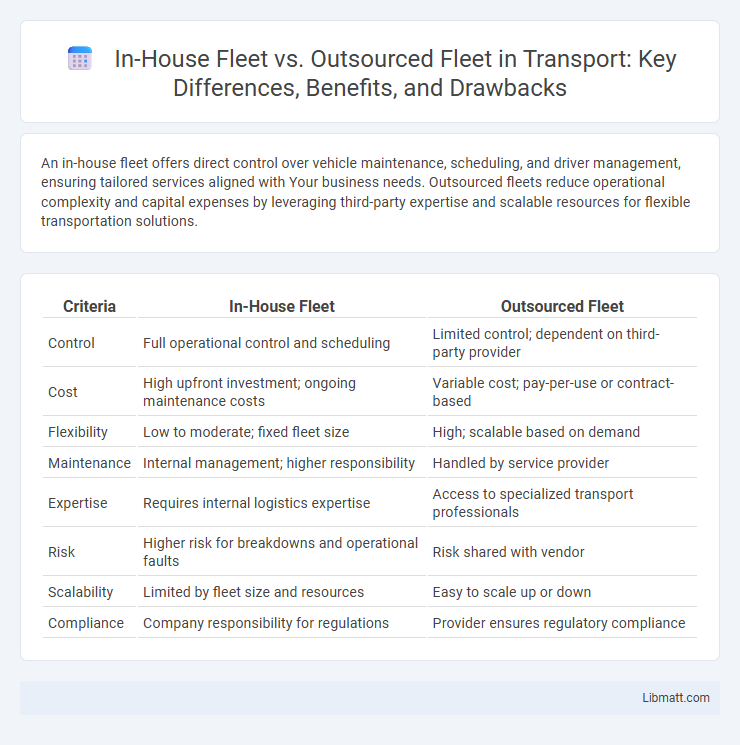An in-house fleet offers direct control over vehicle maintenance, scheduling, and driver management, ensuring tailored services aligned with Your business needs. Outsourced fleets reduce operational complexity and capital expenses by leveraging third-party expertise and scalable resources for flexible transportation solutions.
Table of Comparison
| Criteria | In-House Fleet | Outsourced Fleet |
|---|---|---|
| Control | Full operational control and scheduling | Limited control; dependent on third-party provider |
| Cost | High upfront investment; ongoing maintenance costs | Variable cost; pay-per-use or contract-based |
| Flexibility | Low to moderate; fixed fleet size | High; scalable based on demand |
| Maintenance | Internal management; higher responsibility | Handled by service provider |
| Expertise | Requires internal logistics expertise | Access to specialized transport professionals |
| Risk | Higher risk for breakdowns and operational faults | Risk shared with vendor |
| Scalability | Limited by fleet size and resources | Easy to scale up or down |
| Compliance | Company responsibility for regulations | Provider ensures regulatory compliance |
Introduction to In-House and Outsourced Fleets
In-house fleets offer companies full control over vehicle management, maintenance schedules, and driver training, ensuring alignment with your specific operational goals and brand standards. Outsourced fleets leverage third-party expertise, often resulting in cost savings, scalability, and access to advanced logistics technology without the burden of direct management. Choosing between in-house and outsourced fleets depends on factors like budget, desired control level, and strategic priorities.
Key Differences Between In-House and Outsourced Fleets
In-house fleets offer complete control over vehicle management, maintenance schedules, and driver training, enabling tailored operational efficiency. Outsourced fleets provide cost savings by leveraging third-party expertise, reducing capital expenditures, and offering scalable flexibility for fluctuating demand. Your choice depends on balancing direct oversight with cost optimization and operational agility.
Cost Considerations: In-House vs Outsourced Fleet
In-house fleets typically incur higher fixed costs due to vehicle purchases, maintenance, insurance, and dedicated staffing, while outsourced fleets convert these expenses into variable costs based on usage, offering more financial flexibility. Your choice between in-house and outsourced fleet management impacts budget allocation, as maintaining control over assets often leads to better long-term cost predictability, whereas outsourcing can reduce capital expenditures and shift risks to the service provider. Evaluating total cost of ownership, including hidden expenses like administrative overhead and downtime, is essential to optimize fleet-related financial performance.
Control and Flexibility in Fleet Operations
In-house fleets offer maximum control over vehicle maintenance, driver management, and scheduling, ensuring your operations align precisely with company standards and goals. Outsourced fleets provide greater flexibility to scale services up or down quickly without the overhead costs and complexities of direct management. Choosing the right approach depends on your business's need for direct oversight versus adaptable resource allocation.
Operational Efficiency and Performance
In-house fleets offer direct control over vehicle maintenance, driver training, and scheduling, resulting in improved operational efficiency and consistent performance metrics tailored to company standards. Outsourced fleets leverage specialized logistics providers' expertise and technology, enabling scalability and access to advanced tracking systems that optimize route planning and reduce downtime. Both models impact operational efficiency through different mechanisms: in-house fleets excel in customization and compliance, while outsourced fleets benefit from cost efficiency and flexibility in dynamic demand environments.
Scalability and Growth Potential
In-house fleets offer limited scalability due to fixed resources and higher operational costs, restricting rapid expansion. Outsourced fleets provide flexible capacity, allowing businesses to scale transportation needs efficiently during peak demand or growth phases. Your company can leverage outsourced fleet services to adapt quickly without significant capital investment, supporting long-term growth potential.
Risk Management and Liability Issues
In-house fleet management offers greater control over risk management protocols and direct accountability for vehicle maintenance and driver safety, reducing liability exposure. Outsourced fleets transfer many liability concerns to third-party providers, often backed by contractual agreements and insurance coverage that mitigate client risk. Companies must weigh in-house oversight benefits against outsourced fleet liability protections when deciding the optimal risk management strategy.
Technology Integration and Data Access
In-house fleets offer seamless technology integration, enabling direct control over telematics systems, GPS tracking, and maintenance software, which enhances real-time data access and operational efficiency. Outsourced fleets rely on third-party providers, often resulting in limited data transparency and delayed access to performance metrics due to fragmented technology platforms. Choosing in-house fleet management ensures superior synchronization of fleet management software with enterprise systems, facilitating immediate data insights and optimized decision-making.
Staffing and Human Resource Implications
Managing an in-house fleet requires dedicated staffing, including hiring skilled drivers, maintenance personnel, and administrative support, which increases your human resource responsibilities and costs. Outsourced fleets transfer staffing challenges to third-party providers, allowing you to reduce internal HR complexities such as recruitment, training, and employee retention. Evaluating these staffing implications helps optimize operational efficiency and control over workforce management.
Choosing the Best Fleet Model for Your Business
Selecting the ideal fleet model for your business hinges on factors such as cost control, operational flexibility, and core competency focus. In-house fleets offer direct management, enhanced customization, and potential long-term savings but require significant capital investment and maintenance resources. Outsourced fleets provide scalability, access to specialized expertise, and reduced administrative burden, making them suitable for businesses prioritizing agility and cost predictability.
in-house fleet vs outsourced fleet Infographic

 libmatt.com
libmatt.com